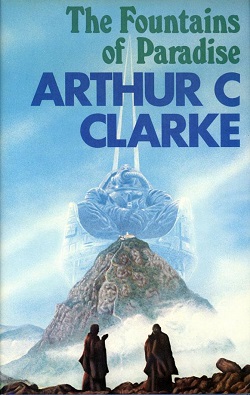This is an old revision of this page, as edited by Wmahan (talk | contribs) at 07:14, 7 September 2004 (expand article, +cat, no longer a stub). The present address (URL) is a permanent link to this revision, which may differ significantly from the current revision.
Revision as of 07:14, 7 September 2004 by Wmahan (talk | contribs) (expand article, +cat, no longer a stub)(diff) ← Previous revision | Latest revision (diff) | Newer revision → (diff)| The Fountains of Paradise | ||
|---|---|---|

| ||
| Novel by Arthur C. Clarke | ||
| Released | 1979 | |
| Original publisher (U.S.) | Ballantine/Del Rey Books | |
| Genre | Science fiction | |
| Professional reviews | ||
| SF Site | Rich Horton | link |
| SF Reviews.Net | T. M. Wagner | link |
| Awards | ||
| Hugo Award | Best Novel | 1980 |
| Nebula Award | Best Novel | 1979 |
The Fountains of Paradise is a novel by Arthur C. Clarke. Set in the 22nd century, it describes the construction of a space elevator. This orbital "beanstalk" is a giant structure rising from the ground and linking with a satellite in geostationary or Clarke Orbit at the height of approximately 36,000 kilometers. Such a structure would be used to efficiently and effectively raise payloads to orbit without having to use rockets.
In the novel, Clarke uses the life of the ancient king Kalidasa to foreshadow the adventures of engineer Vannevar Morgan in his single-minded determination to realize the space elevator. Subplots in the novel include human colonization of the solar system and the first contact with extraterrestrial intelligence. Clarke also hypothesizes that religion in humans is a consequence of sexual reproduction, although the idea does not play a central role in the novel. The Fountains of Paradise is set in the fictional country of Taprobane, which Clarke has described as "about ninety percent congruent with the island of Ceylon (now Sri Lanka)".
In the novel, Clarke envisions a microscopically thin but strong "hyperfilament" that makes the elevator possible. Although the hyperfilament is constructed from diamond in the novel, Clarke later expressed his belief that another type of carbon, Buckminsterfullerene, would play the role of hyperfilament in a real space elevator.
Categories: